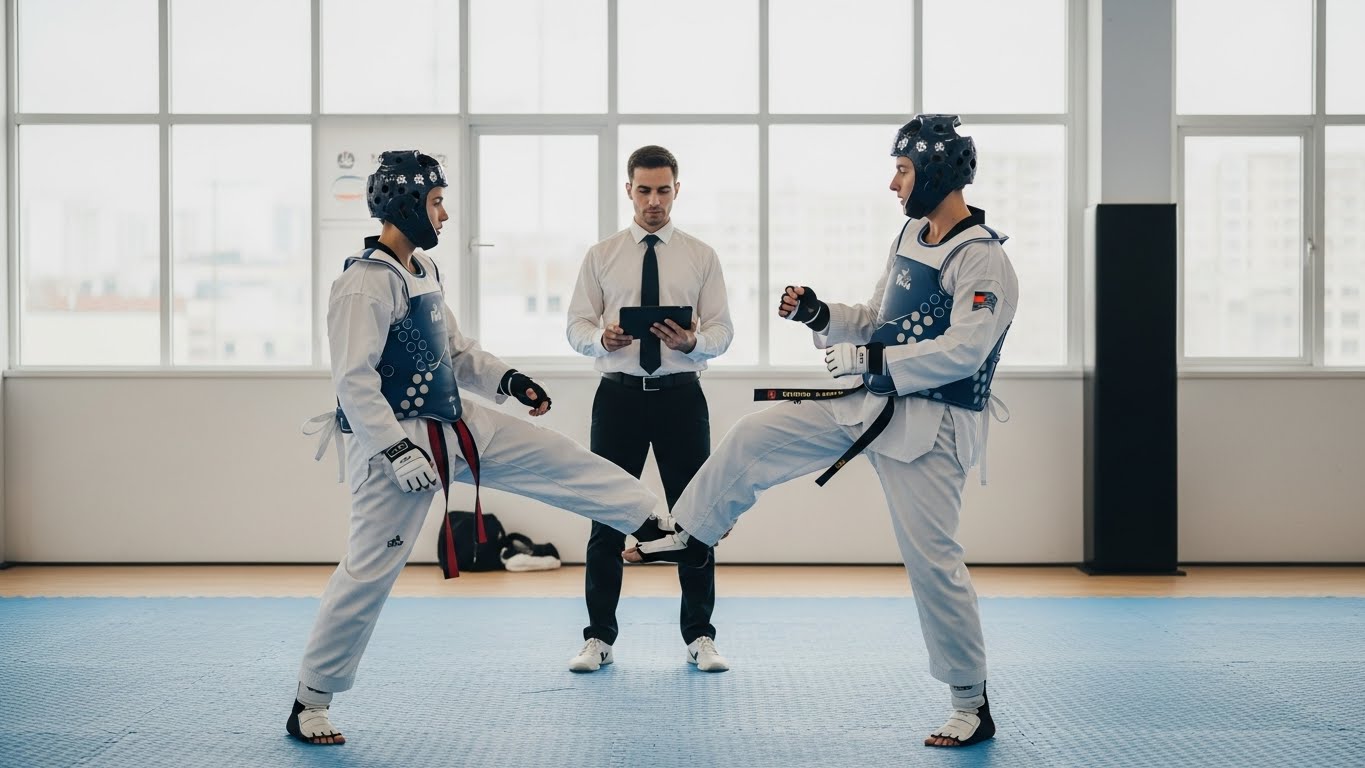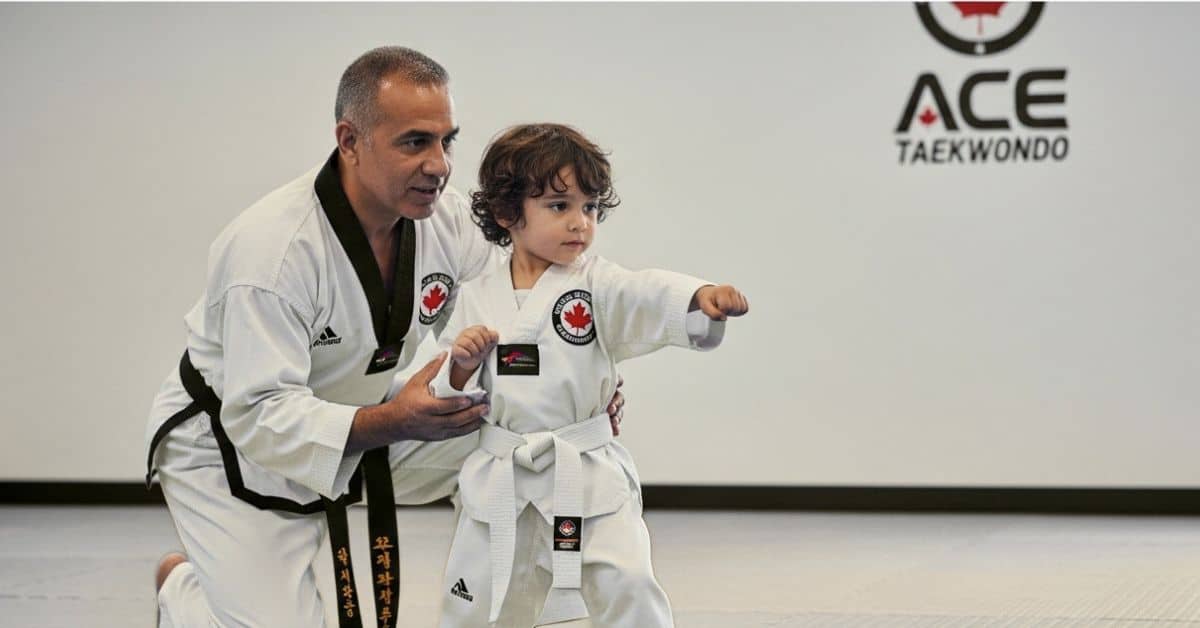As a Taekwondo Master and the lead instructor at Ace Taekwondo, I often remind my students that kicks are the soul of this art. Taekwondo is famous for its dynamic and powerful leg techniques. When you practise them with discipline and patience, you build not only strength but also speed, balance, and confidence.
In this guide, I’ll share the top 10 Taekwondo kicks you must learn. These are the same kicks I teach in my classes, starting with the basics and moving toward advanced levels. Whether you’re a beginner or an experienced martial artist, mastering these kicks will give you a solid foundation in Korean martial arts kicking styles.
1: Front Kick (Ap Chagi) – The Starting Point
The front kick is one of the most basic Taekwondo kicks every student learns first. It’s simple, direct, and effective in self-defence. You lift your knee, extend your leg forward, and strike with the ball of your foot.
This kick teaches balance and timing. In self-defence, it can stop an opponent from coming closer. In training, it strengthens the core and legs. I often include this kick in Taekwondo training drills for kicks because it sets the stage for everything else.
2: Roundhouse Kick (Dollyo Chagi) – The Crowd Favourite
If you’ve ever watched a Taekwondo match, you’ve likely seen the roundhouse kick. It’s fast, sharp, and powerful. This kick uses the top of the foot or shin to strike.
Students love this kick because it feels natural once you learn the step-by-step martial arts kicks method. It’s also one of the most powerful Taekwondo kicks in sparring and can be adapted into countless Taekwondo kicking combinations.
3: Side Kick (Yop Chagi) – The Power Kick
The side kick is known for its raw power. You thrust your leg out sideways, hitting with the heel. It’s excellent for both attack and defence.
I train my students to use this kick to build leg strength and flexibility in martial arts. When done correctly, it can knock back even a strong opponent. It also teaches students about precision, as accuracy is key for this strike.
4: Axe Kick (Naeryo Chagi) – The Dropping Strike
The axe kick comes from high above, dropping straight down onto the target. It’s unique to Taekwondo and looks spectacular in demonstrations.
This kick requires good high kicks and spinning kicks flexibility. I always remind students to stretch before practising this kick to prevent injury. In sparring, it can surprise an opponent by breaking through their guard.
5: Back Kick (Dwi Chagi) – The Counter Attack
The back kick is one of the strongest in Taekwondo. You turn slightly, look over your shoulder, and drive your heel backward into the target.
It’s great for self-defence kicks in Taekwondo, especially when someone rushes from behind. Many beginners struggle with balance here, but with practice, it becomes a reliable tool in sparring and real-life defence.
6: Hook Kick (Huryeo Chagi) – The Whip Motion
The hook kick moves like a whip. You swing your leg across and snap it back into the target. The striking surface is usually the heel.
This kick is often used in advanced Taekwondo kicking techniques. It requires timing and control. I often pair it with roundhouse or side kicks to teach Taekwondo kicking combinations. Students enjoy it because it feels stylish and powerful once mastered.
7: Crescent Kick (Bandal Chagi) – The Arc Kick
The crescent kick makes a smooth arc, striking with either the inside or outside of the foot. It looks elegant but also has solid applications.
In my classes, I teach this kick to improve balance and control. It’s also a stepping stone to learning spinning kicks. The crescent kick improves hip flexibility, which is crucial for advanced martial arts techniques.
8: Spinning Back Kick (Bandae Dwi Chagi) – The Knockout Kick
The spinning back kick is often considered one of the most powerful Taekwondo kicks. You spin fully and drive your heel into the target.
It combines speed, surprise, and strength. Many fighters use it as a knockout move. I always advise students to master the basic back kick first, then progress to this more advanced version. It’s a true test of balance and focus.
9: Jumping Kick – The Power Booster
Adding a jump to any kick gives it more impact. A jumping front kick or jumping side kick can break boards and impress audiences in demonstrations.
Jumping kicks build stamina and leg power. They also challenge your timing and coordination. In Taekwondo training drills for kicks, I often include jumping variations to push students beyond their comfort zone.
10: Tornado Kick (Huryeo Narae Chagi) – The Showstopper
The tornado kick is one of the flashiest moves in Taekwondo. It’s a spinning jump kick that combines speed, style, and power.
This kick belongs to the group of advanced Taekwondo kicking techniques and is a favourite in competitions. It requires excellent leg strength and flexibility in martial arts. Students who master it feel a great sense of achievement.
How to Practise These Kicks Effectively
Learning kicks is more than just repetition. You need drills, combinations, and proper guidance. Here are a few training tips I give my students:
- Warm up well: Stretch to prepare your hips and legs.
- Practise slowly first: Perfect your form before adding speed.
- Train in sets: For example, 10 front kicks per leg, 5 rounds.
- Combine kicks: Mix front and roundhouse, or side and hook.
- Focus on balance: A strong stance makes your kick stronger.
Practising Taekwondo training drills for kicks regularly will build both skill and confidence.
Why These Kicks Matter
These basic Taekwondo kicks and advanced moves form the backbone of your training. They improve speed, control, and awareness. More importantly, they give you the ability to defend yourself if needed.
At Ace Taekwondo, I teach these kicks not just as techniques but as lessons in discipline and focus. Students learn that every strike is about control, respect, and self-improvement.
Final Thoughts from Master Viresh
Mastering these top 10 Taekwondo kicks takes time, effort, and patience. Start with the basics, practise with dedication, and aim for precision before power.
As your instructor, I believe that each kick is more than a move. It’s a way to train your body and mind together. Keep training, stay consistent, and you’ll see progress both inside and outside the dojang.
If you’re ready to begin or advance your training, visit us at Ace Taekwondo. Join our classes, and I’ll guide you step by step through these kicks — from the simplest front kick to the exciting tornado kick.
Read more: How Taekwondo Became an Olympic Sport
Frequently Asked Questions
What are the first Taekwondo kicks I should learn?
Most new students begin with the front kick, roundhouse kick, and side kick. These kicks are simple, build balance, and help you learn control before moving to harder moves.
Which Taekwondo kick is the strongest?
The spinning back kick is often called the strongest kick in Taekwondo. It is fast, powerful, and works well for both sparring and self-defence.
How do I get better at Taekwondo kicks at home?
To improve, keep practising basic drills, stretch often for flexible legs, and repeat simple kick sets like front and roundhouse kicks. Training a little every day helps you get faster and stronger.









